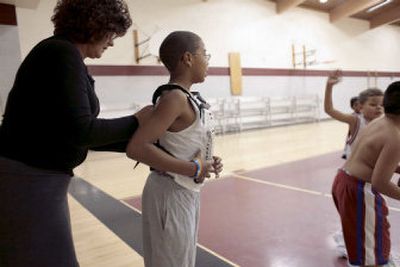Rare disease not slowing Yakima boy

YAKIMA – Lanky, long and lithe, DeVonte Combs is a basketball coach’s dream.
At least a foot taller than anyone else in his class, he’s the type of youngster sports fans watch through the years with gleeful anticipation.
But there won’t be any Seattle SuperSonics uniform in the 7-year-old’s future.
He’s been told, in fact, to stop playing basketball before he gets to high school.
That’s because he has Marfan syndrome, a genetically inherited, connective-tissue disease that causes defects in the body’s skeletal structure, eyes and heart.
Affecting one in 5,000 people, according to the National Marfan Foundation, those diagnosed are often unusually tall and thin with disproportionately long limbs. Some geneticists conjecture that Abraham Lincoln may have suffered from the condition.
About an inch shy of 5 feet (the height of an average 12-year-old), DeVonte wears a size 8 men’s shoe and 28-inch-waist pants. Last year, he started taking a beta blocker to relieve pressure on his aorta.
His mother, Charmin Williams, 26, says her son has always been big. “I never really felt like I had a baby,” she says.
At birth, DeVonte was 9 pounds, 1 ounce and stretched 24 inches in length.
By age 2, he was on his way to being 4 feet tall.
“I’ve always asked if there was something wrong with him from the time he was a year old. In the back of my head and stomach, I knew there was something …,” Williams says.
Her suspicions were confirmed last year. It started when DeVonte had trouble passing a routine eye exam given when he was in kindergarten at Lince Elementary School in Selah.
The youngster was referred to an optometrist, who discovered that both of DeVonte’s lenses were detached.
In a child so young, that finding is a red flag, and unfortunately, a key indicator of Marfan.
“I’d never heard of it,” says Williams, nor did anyone in the family know anyone else with Marfan syndrome.
“We’ve been told that he’s the youngest person ever to have Marfan’s in Yakima,” says DeVonte’s grandmother, Dorothy Harmon, noting that the syndrome more commonly manifests in the late teens.
After the diagnosis was confirmed at Children’s Village in Yakima, the family began taking DeVonte to Seattle for twice-yearly appointments at Children’s Hospital.
Williams explains that the disease has not only affected the first-grader’s eyes – glasses were prescribed a year ago – but also his cardiac system; his aorta is dilated, and he has a leaky valve.
Fortunately, says Williams, her son doesn’t display any skeletal symptoms, such as joint and spine problems.
For his part, DeVonte knows he has something called Marfan’s, but “it hasn’t registered that it’s a lifelong condition for him,” explains Williams.
Because his aorta is vulnerable to damage, DeVonte has been cautioned to protect his chest during physical activity. That means when he plays basketball, he wears a plastic shield over his torso, similar to ones worn by hockey players.
“He really doesn’t like it,” his mom concedes, but since the shield is a potential lifesaver, the family stresses that DeVonte must learn to be cautious around others to avoid injuries.
So far, two sports have been ruled out: weightlifting and football. Other than that, anything goes, for now.
“I like playing basketball and skateboarding best,” DeVonte says.
And much more – swimming (he favors freestyle), snow sports (he’s converting an old skateboard into a snowboard), soccer and baseball.
“He never slows down,” his mom comments.
Last year, DeVonte played on an AAU basketball team for kindergartners, but he was so much taller than the other players, no one could pass the ball over him.
This year, the coaches put him on a second-grade team, where he still looks like a skyscraper compared with the older children.
And there’s the rub; because DeVonte looks so much older than he is, he’s often expected to act more mature than he is, Williams laments.
He even fools himself. “It’s hard for him to realize that he’s only 7,” his mom says. “But mentally he’s still little.”
Although DeVonte is happiest being outdoors – “I like recess best,” he confirms – he also enjoys drawing with pencils, collecting small cars and building with Legos.
In trying to catch up with his size, the youngster has developed a fairly respectable appetite, routinely devouring his favorites: pizza, chicken, vanilla and strawberry ice cream, scrambled eggs, Top Ramen.
Because of DeVonte’s lofty height and rare condition, his mom realizes that he will probably always attract attention. But she’s determined that his life will be as normal as possible.
“He gets no special treatment,” she emphasizes. “He’s not broken. He just has a syndrome.”
After the initial shock of hearing the term “Marfan” and what it would mean, both Williams and Harmon are intent upon spreading the word about the syndrome’s symptoms. They want to be sure that other children and teens can benefit from an early diagnosis.
They’ve both done extensive research on Marfan’s and the long-term prognosis.
While the average life expectancy of someone with Marfan’s is said to be in the mid-30s, new developments in treating the disease show potential. Not only are experimental drugs being tested to prevent aortic failure in Marfan’s patients, but the defective gene that causes the syndrome has been discovered. That could lead to treatment of the gene sometime in the future.
To DeVonte’s mother, Marfan’s has become a way of life – a life she’s going to make sure her son lives to the utmost.
“It’s not the end of the world,” Williams says.
“He may be different, but since it’s not going away, we’re going to deal with it.”